Domestic Violence: A Public Health Issue in Australia
VerifiedAdded on 2023/06/09
|11
|2975
|425
AI Summary
Domestic violence is a serious public health issue in Australia. This article discusses the impact of domestic violence on mental health and well-being, and the socio-economic and psychological factors that contribute to it. It also explores the Australian perspective on domestic violence and the efforts being made to reduce its incidence.
Contribute Materials
Your contribution can guide someone’s learning journey. Share your
documents today.
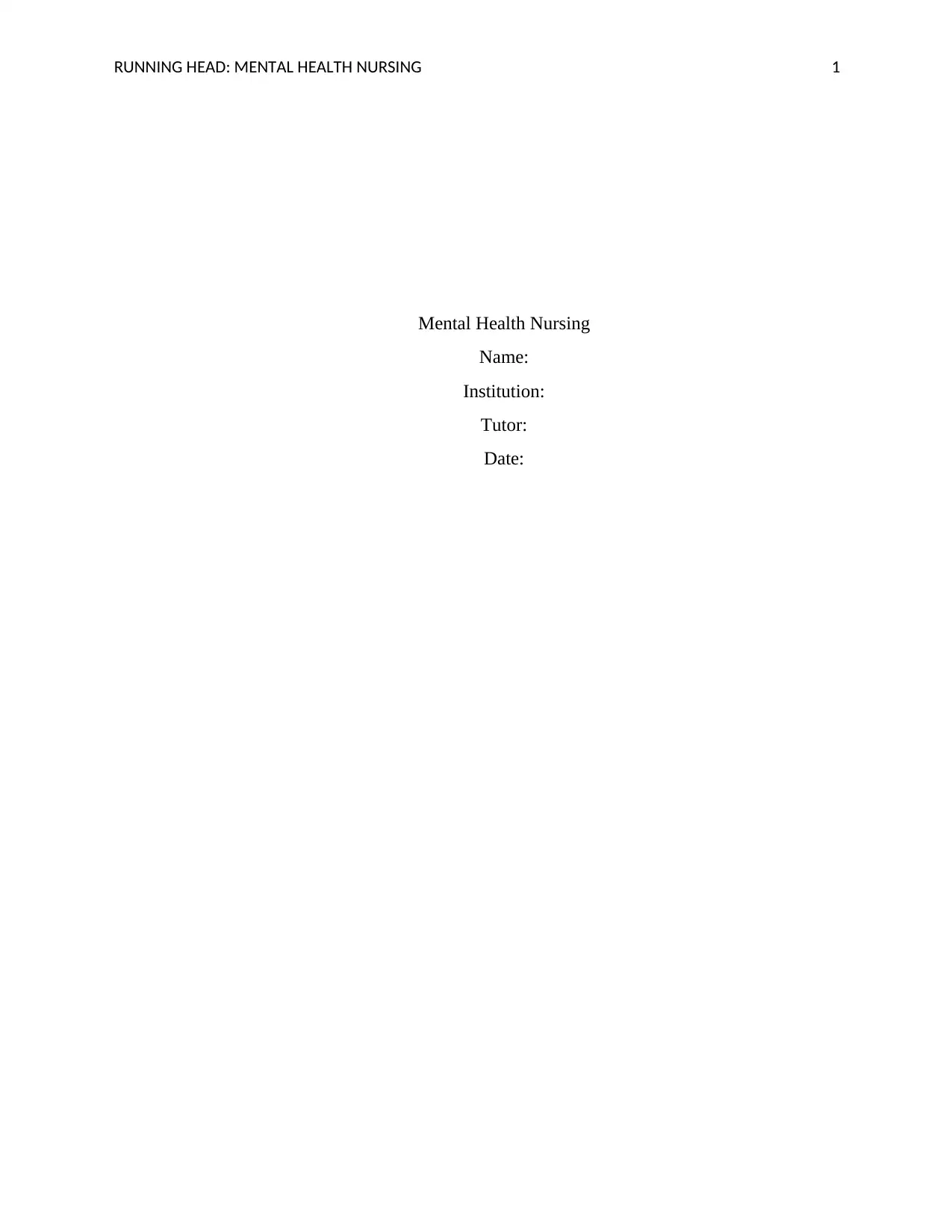
RUNNING HEAD: MENTAL HEALTH NURSING 1
Mental Health Nursing
Name:
Institution:
Tutor:
Date:
Mental Health Nursing
Name:
Institution:
Tutor:
Date:
Secure Best Marks with AI Grader
Need help grading? Try our AI Grader for instant feedback on your assignments.
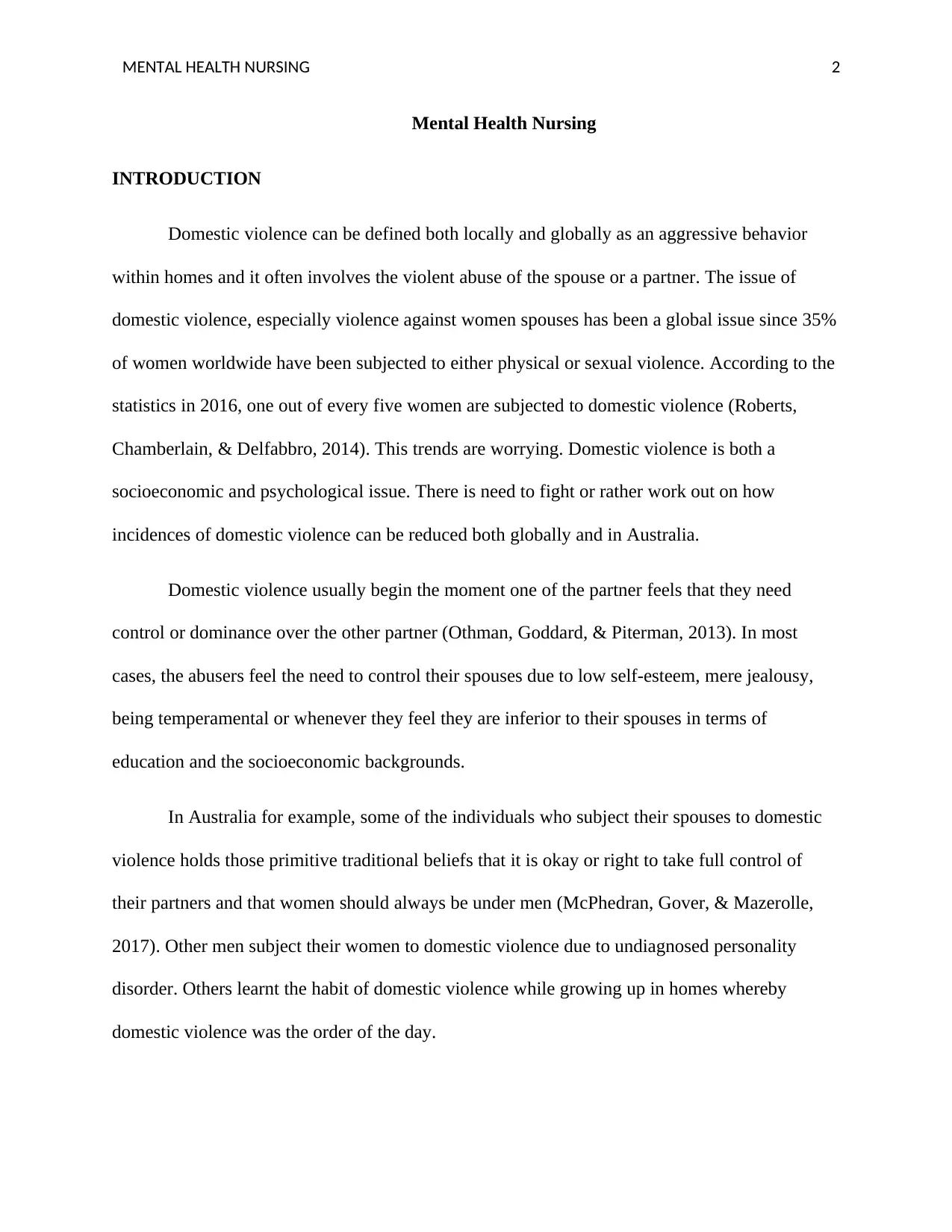
MENTAL HEALTH NURSING 2
Mental Health Nursing
INTRODUCTION
Domestic violence can be defined both locally and globally as an aggressive behavior
within homes and it often involves the violent abuse of the spouse or a partner. The issue of
domestic violence, especially violence against women spouses has been a global issue since 35%
of women worldwide have been subjected to either physical or sexual violence. According to the
statistics in 2016, one out of every five women are subjected to domestic violence (Roberts,
Chamberlain, & Delfabbro, 2014). This trends are worrying. Domestic violence is both a
socioeconomic and psychological issue. There is need to fight or rather work out on how
incidences of domestic violence can be reduced both globally and in Australia.
Domestic violence usually begin the moment one of the partner feels that they need
control or dominance over the other partner (Othman, Goddard, & Piterman, 2013). In most
cases, the abusers feel the need to control their spouses due to low self-esteem, mere jealousy,
being temperamental or whenever they feel they are inferior to their spouses in terms of
education and the socioeconomic backgrounds.
In Australia for example, some of the individuals who subject their spouses to domestic
violence holds those primitive traditional beliefs that it is okay or right to take full control of
their partners and that women should always be under men (McPhedran, Gover, & Mazerolle,
2017). Other men subject their women to domestic violence due to undiagnosed personality
disorder. Others learnt the habit of domestic violence while growing up in homes whereby
domestic violence was the order of the day.
Mental Health Nursing
INTRODUCTION
Domestic violence can be defined both locally and globally as an aggressive behavior
within homes and it often involves the violent abuse of the spouse or a partner. The issue of
domestic violence, especially violence against women spouses has been a global issue since 35%
of women worldwide have been subjected to either physical or sexual violence. According to the
statistics in 2016, one out of every five women are subjected to domestic violence (Roberts,
Chamberlain, & Delfabbro, 2014). This trends are worrying. Domestic violence is both a
socioeconomic and psychological issue. There is need to fight or rather work out on how
incidences of domestic violence can be reduced both globally and in Australia.
Domestic violence usually begin the moment one of the partner feels that they need
control or dominance over the other partner (Othman, Goddard, & Piterman, 2013). In most
cases, the abusers feel the need to control their spouses due to low self-esteem, mere jealousy,
being temperamental or whenever they feel they are inferior to their spouses in terms of
education and the socioeconomic backgrounds.
In Australia for example, some of the individuals who subject their spouses to domestic
violence holds those primitive traditional beliefs that it is okay or right to take full control of
their partners and that women should always be under men (McPhedran, Gover, & Mazerolle,
2017). Other men subject their women to domestic violence due to undiagnosed personality
disorder. Others learnt the habit of domestic violence while growing up in homes whereby
domestic violence was the order of the day.
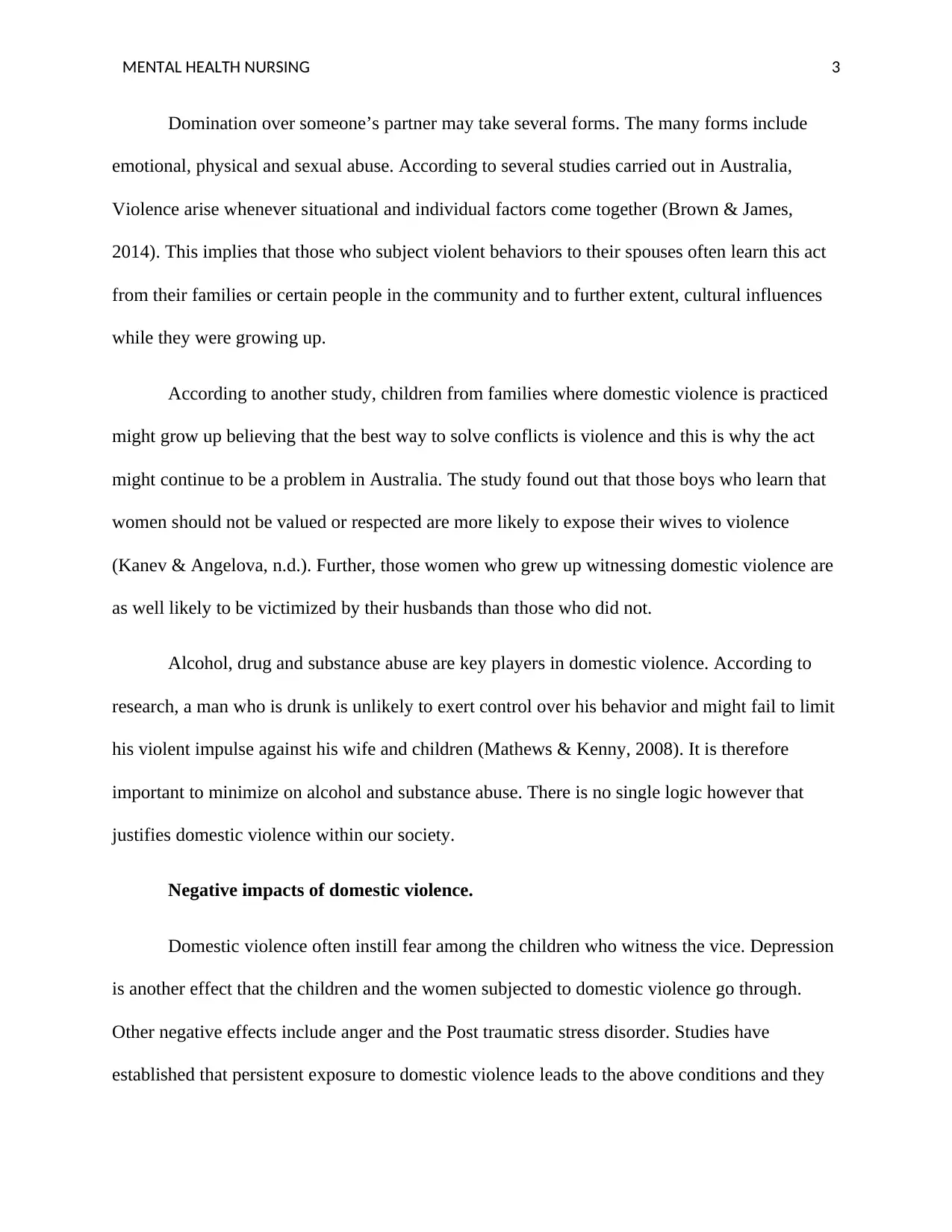
MENTAL HEALTH NURSING 3
Domination over someone’s partner may take several forms. The many forms include
emotional, physical and sexual abuse. According to several studies carried out in Australia,
Violence arise whenever situational and individual factors come together (Brown & James,
2014). This implies that those who subject violent behaviors to their spouses often learn this act
from their families or certain people in the community and to further extent, cultural influences
while they were growing up.
According to another study, children from families where domestic violence is practiced
might grow up believing that the best way to solve conflicts is violence and this is why the act
might continue to be a problem in Australia. The study found out that those boys who learn that
women should not be valued or respected are more likely to expose their wives to violence
(Kanev & Angelova, n.d.). Further, those women who grew up witnessing domestic violence are
as well likely to be victimized by their husbands than those who did not.
Alcohol, drug and substance abuse are key players in domestic violence. According to
research, a man who is drunk is unlikely to exert control over his behavior and might fail to limit
his violent impulse against his wife and children (Mathews & Kenny, 2008). It is therefore
important to minimize on alcohol and substance abuse. There is no single logic however that
justifies domestic violence within our society.
Negative impacts of domestic violence.
Domestic violence often instill fear among the children who witness the vice. Depression
is another effect that the children and the women subjected to domestic violence go through.
Other negative effects include anger and the Post traumatic stress disorder. Studies have
established that persistent exposure to domestic violence leads to the above conditions and they
Domination over someone’s partner may take several forms. The many forms include
emotional, physical and sexual abuse. According to several studies carried out in Australia,
Violence arise whenever situational and individual factors come together (Brown & James,
2014). This implies that those who subject violent behaviors to their spouses often learn this act
from their families or certain people in the community and to further extent, cultural influences
while they were growing up.
According to another study, children from families where domestic violence is practiced
might grow up believing that the best way to solve conflicts is violence and this is why the act
might continue to be a problem in Australia. The study found out that those boys who learn that
women should not be valued or respected are more likely to expose their wives to violence
(Kanev & Angelova, n.d.). Further, those women who grew up witnessing domestic violence are
as well likely to be victimized by their husbands than those who did not.
Alcohol, drug and substance abuse are key players in domestic violence. According to
research, a man who is drunk is unlikely to exert control over his behavior and might fail to limit
his violent impulse against his wife and children (Mathews & Kenny, 2008). It is therefore
important to minimize on alcohol and substance abuse. There is no single logic however that
justifies domestic violence within our society.
Negative impacts of domestic violence.
Domestic violence often instill fear among the children who witness the vice. Depression
is another effect that the children and the women subjected to domestic violence go through.
Other negative effects include anger and the Post traumatic stress disorder. Studies have
established that persistent exposure to domestic violence leads to the above conditions and they

MENTAL HEALTH NURSING 4
are often expressed through nightmares, insomnia, anxiety as well as increased alertness to the
environment and difficulties in concentrating.
Mental health and well-being.
Mental health and well-being can be well defined as the ability of an individual to realize
his or her own potential and be able to cope with stress of life, work productively and fruitfully
and then be able to make meaningful contribution to their community.
Domestic violence as health issue
According to the world Health Organization, health is defined as the state of full physical,
mental and social well-being and not just the perception about the absence of disease or
infirmity. Based on this simple definition, it is apparently clear that domestic violence is a
serious health issue especially in Australia (Lumsden & Morgan, 2017) .This was first declared
by a surgeon in the United States of America in 1984.
The most common form of domestic violence is physical violence and it leads to
extensive injuries, abortions and even murder to a further extend. According to statistics in
Australia, 62% of women die as a result of murder that arise from domestic violence. These
deaths are caused by a simple social problem which can easily be controlled.
Both physical and psychological violence as well as denial of both the physical and
economic resources has a very big impact on the mental health of women .According to research,
victimization alone is a very big risk factor towards the development of a woman’s mental health
(Clancey, 2015) .These problems come in different forms but they all affect the woman’s ability
to get good quality life both to herself and her family. According to Facts About Domestic
violence, alcoholism and drug abuse are the leading causes of violence in women. Besides, they
are often expressed through nightmares, insomnia, anxiety as well as increased alertness to the
environment and difficulties in concentrating.
Mental health and well-being.
Mental health and well-being can be well defined as the ability of an individual to realize
his or her own potential and be able to cope with stress of life, work productively and fruitfully
and then be able to make meaningful contribution to their community.
Domestic violence as health issue
According to the world Health Organization, health is defined as the state of full physical,
mental and social well-being and not just the perception about the absence of disease or
infirmity. Based on this simple definition, it is apparently clear that domestic violence is a
serious health issue especially in Australia (Lumsden & Morgan, 2017) .This was first declared
by a surgeon in the United States of America in 1984.
The most common form of domestic violence is physical violence and it leads to
extensive injuries, abortions and even murder to a further extend. According to statistics in
Australia, 62% of women die as a result of murder that arise from domestic violence. These
deaths are caused by a simple social problem which can easily be controlled.
Both physical and psychological violence as well as denial of both the physical and
economic resources has a very big impact on the mental health of women .According to research,
victimization alone is a very big risk factor towards the development of a woman’s mental health
(Clancey, 2015) .These problems come in different forms but they all affect the woman’s ability
to get good quality life both to herself and her family. According to Facts About Domestic
violence, alcoholism and drug abuse are the leading causes of violence in women. Besides, they
Secure Best Marks with AI Grader
Need help grading? Try our AI Grader for instant feedback on your assignments.
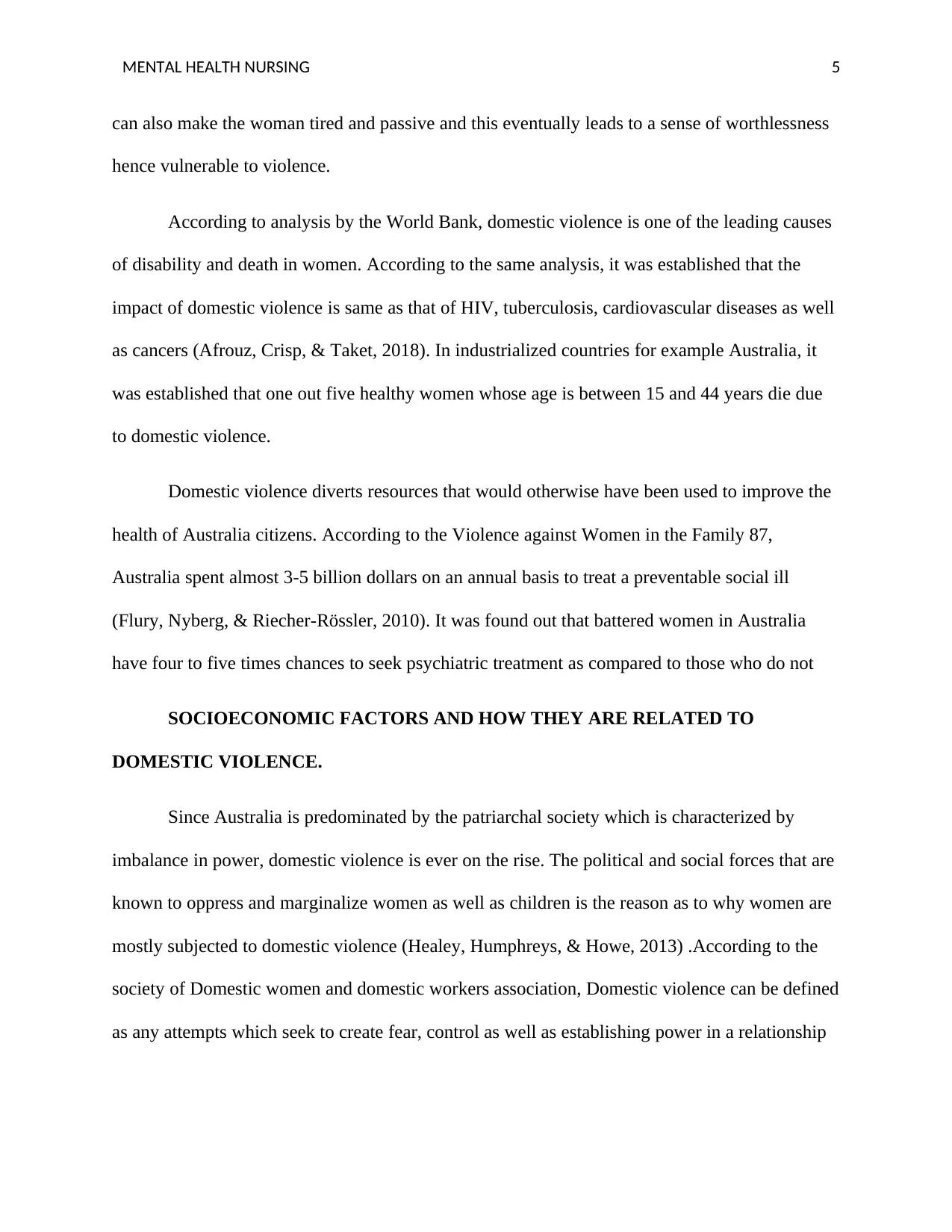
MENTAL HEALTH NURSING 5
can also make the woman tired and passive and this eventually leads to a sense of worthlessness
hence vulnerable to violence.
According to analysis by the World Bank, domestic violence is one of the leading causes
of disability and death in women. According to the same analysis, it was established that the
impact of domestic violence is same as that of HIV, tuberculosis, cardiovascular diseases as well
as cancers (Afrouz, Crisp, & Taket, 2018). In industrialized countries for example Australia, it
was established that one out five healthy women whose age is between 15 and 44 years die due
to domestic violence.
Domestic violence diverts resources that would otherwise have been used to improve the
health of Australia citizens. According to the Violence against Women in the Family 87,
Australia spent almost 3-5 billion dollars on an annual basis to treat a preventable social ill
(Flury, Nyberg, & Riecher-Rössler, 2010). It was found out that battered women in Australia
have four to five times chances to seek psychiatric treatment as compared to those who do not
SOCIOECONOMIC FACTORS AND HOW THEY ARE RELATED TO
DOMESTIC VIOLENCE.
Since Australia is predominated by the patriarchal society which is characterized by
imbalance in power, domestic violence is ever on the rise. The political and social forces that are
known to oppress and marginalize women as well as children is the reason as to why women are
mostly subjected to domestic violence (Healey, Humphreys, & Howe, 2013) .According to the
society of Domestic women and domestic workers association, Domestic violence can be defined
as any attempts which seek to create fear, control as well as establishing power in a relationship
can also make the woman tired and passive and this eventually leads to a sense of worthlessness
hence vulnerable to violence.
According to analysis by the World Bank, domestic violence is one of the leading causes
of disability and death in women. According to the same analysis, it was established that the
impact of domestic violence is same as that of HIV, tuberculosis, cardiovascular diseases as well
as cancers (Afrouz, Crisp, & Taket, 2018). In industrialized countries for example Australia, it
was established that one out five healthy women whose age is between 15 and 44 years die due
to domestic violence.
Domestic violence diverts resources that would otherwise have been used to improve the
health of Australia citizens. According to the Violence against Women in the Family 87,
Australia spent almost 3-5 billion dollars on an annual basis to treat a preventable social ill
(Flury, Nyberg, & Riecher-Rössler, 2010). It was found out that battered women in Australia
have four to five times chances to seek psychiatric treatment as compared to those who do not
SOCIOECONOMIC FACTORS AND HOW THEY ARE RELATED TO
DOMESTIC VIOLENCE.
Since Australia is predominated by the patriarchal society which is characterized by
imbalance in power, domestic violence is ever on the rise. The political and social forces that are
known to oppress and marginalize women as well as children is the reason as to why women are
mostly subjected to domestic violence (Healey, Humphreys, & Howe, 2013) .According to the
society of Domestic women and domestic workers association, Domestic violence can be defined
as any attempts which seek to create fear, control as well as establishing power in a relationship
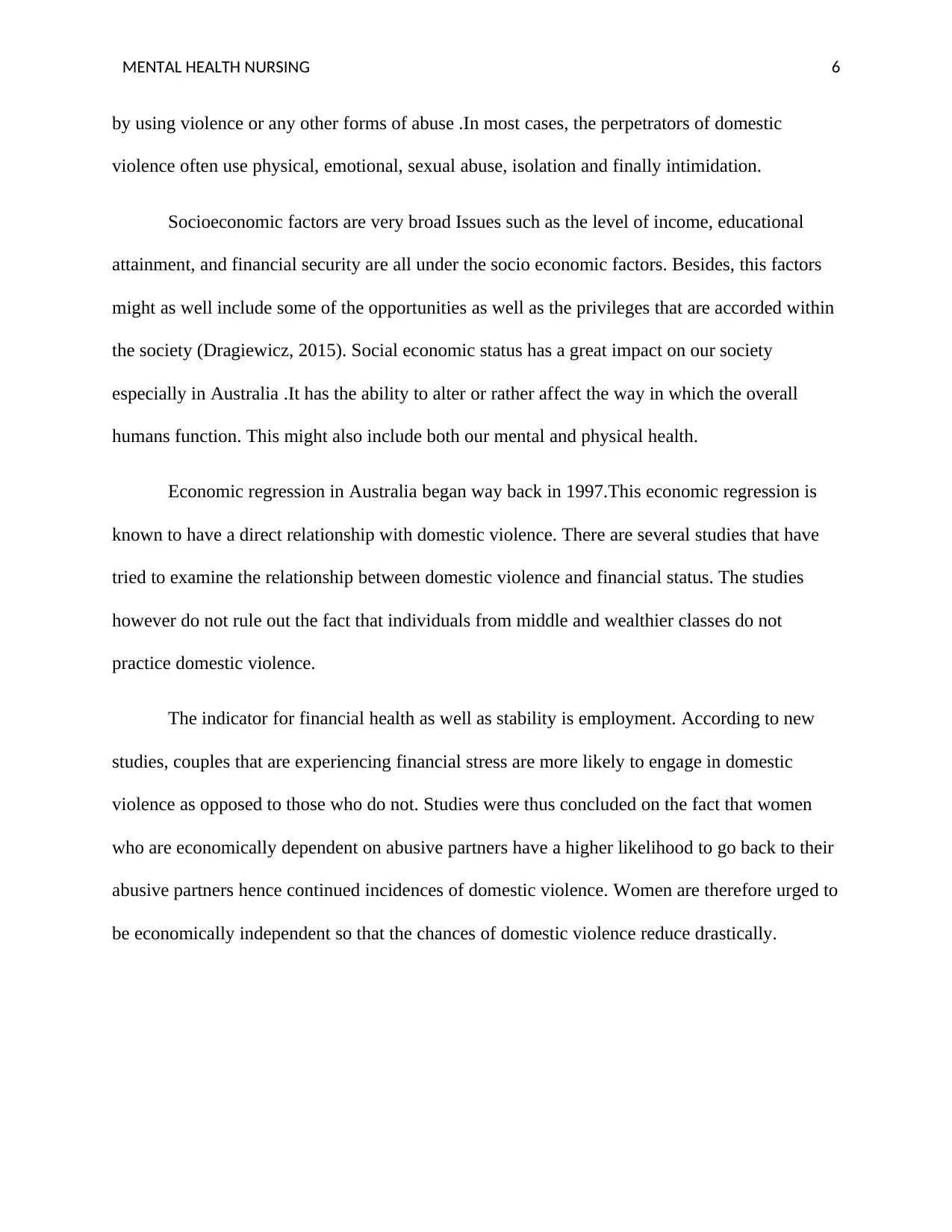
MENTAL HEALTH NURSING 6
by using violence or any other forms of abuse .In most cases, the perpetrators of domestic
violence often use physical, emotional, sexual abuse, isolation and finally intimidation.
Socioeconomic factors are very broad Issues such as the level of income, educational
attainment, and financial security are all under the socio economic factors. Besides, this factors
might as well include some of the opportunities as well as the privileges that are accorded within
the society (Dragiewicz, 2015). Social economic status has a great impact on our society
especially in Australia .It has the ability to alter or rather affect the way in which the overall
humans function. This might also include both our mental and physical health.
Economic regression in Australia began way back in 1997.This economic regression is
known to have a direct relationship with domestic violence. There are several studies that have
tried to examine the relationship between domestic violence and financial status. The studies
however do not rule out the fact that individuals from middle and wealthier classes do not
practice domestic violence.
The indicator for financial health as well as stability is employment. According to new
studies, couples that are experiencing financial stress are more likely to engage in domestic
violence as opposed to those who do not. Studies were thus concluded on the fact that women
who are economically dependent on abusive partners have a higher likelihood to go back to their
abusive partners hence continued incidences of domestic violence. Women are therefore urged to
be economically independent so that the chances of domestic violence reduce drastically.
by using violence or any other forms of abuse .In most cases, the perpetrators of domestic
violence often use physical, emotional, sexual abuse, isolation and finally intimidation.
Socioeconomic factors are very broad Issues such as the level of income, educational
attainment, and financial security are all under the socio economic factors. Besides, this factors
might as well include some of the opportunities as well as the privileges that are accorded within
the society (Dragiewicz, 2015). Social economic status has a great impact on our society
especially in Australia .It has the ability to alter or rather affect the way in which the overall
humans function. This might also include both our mental and physical health.
Economic regression in Australia began way back in 1997.This economic regression is
known to have a direct relationship with domestic violence. There are several studies that have
tried to examine the relationship between domestic violence and financial status. The studies
however do not rule out the fact that individuals from middle and wealthier classes do not
practice domestic violence.
The indicator for financial health as well as stability is employment. According to new
studies, couples that are experiencing financial stress are more likely to engage in domestic
violence as opposed to those who do not. Studies were thus concluded on the fact that women
who are economically dependent on abusive partners have a higher likelihood to go back to their
abusive partners hence continued incidences of domestic violence. Women are therefore urged to
be economically independent so that the chances of domestic violence reduce drastically.
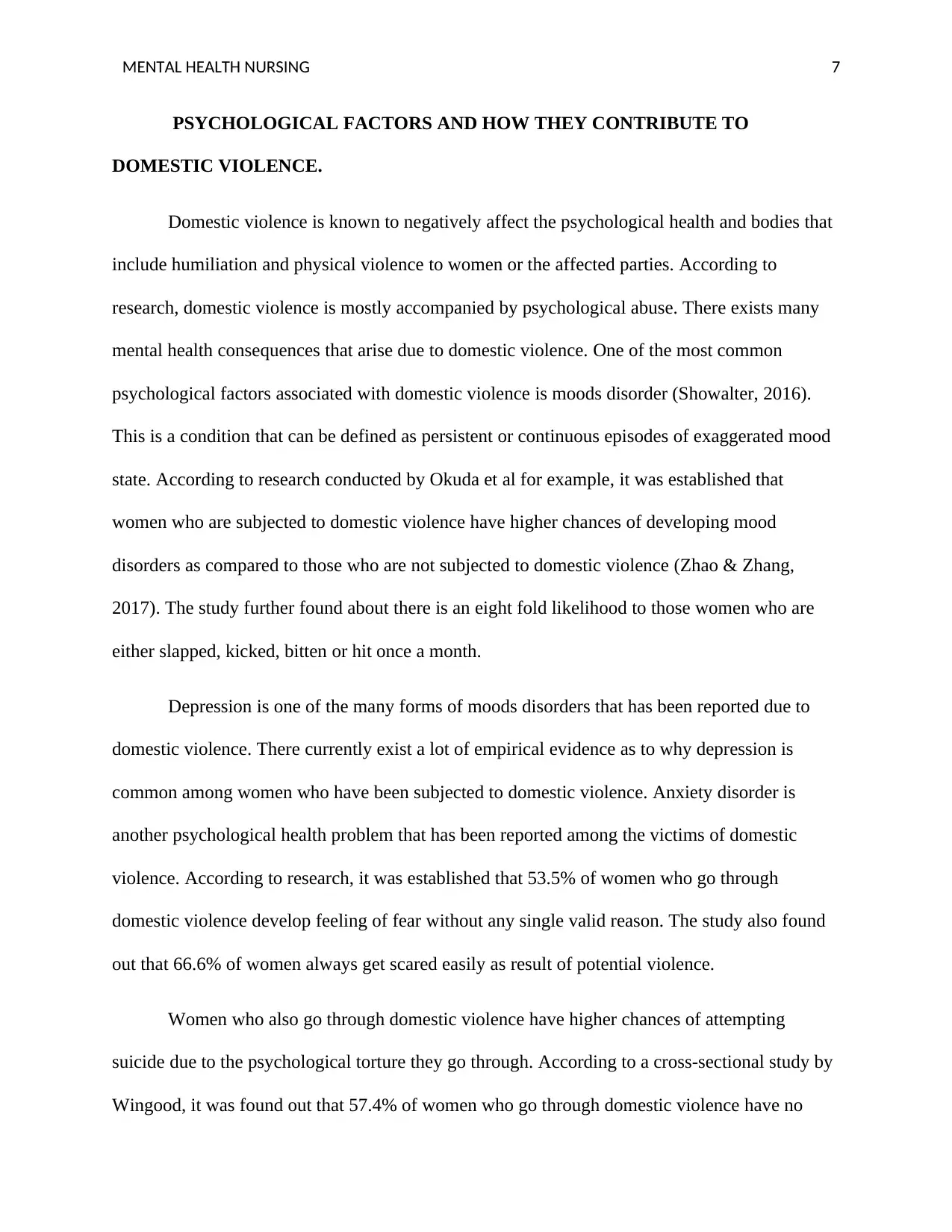
MENTAL HEALTH NURSING 7
PSYCHOLOGICAL FACTORS AND HOW THEY CONTRIBUTE TO
DOMESTIC VIOLENCE.
Domestic violence is known to negatively affect the psychological health and bodies that
include humiliation and physical violence to women or the affected parties. According to
research, domestic violence is mostly accompanied by psychological abuse. There exists many
mental health consequences that arise due to domestic violence. One of the most common
psychological factors associated with domestic violence is moods disorder (Showalter, 2016).
This is a condition that can be defined as persistent or continuous episodes of exaggerated mood
state. According to research conducted by Okuda et al for example, it was established that
women who are subjected to domestic violence have higher chances of developing mood
disorders as compared to those who are not subjected to domestic violence (Zhao & Zhang,
2017). The study further found about there is an eight fold likelihood to those women who are
either slapped, kicked, bitten or hit once a month.
Depression is one of the many forms of moods disorders that has been reported due to
domestic violence. There currently exist a lot of empirical evidence as to why depression is
common among women who have been subjected to domestic violence. Anxiety disorder is
another psychological health problem that has been reported among the victims of domestic
violence. According to research, it was established that 53.5% of women who go through
domestic violence develop feeling of fear without any single valid reason. The study also found
out that 66.6% of women always get scared easily as result of potential violence.
Women who also go through domestic violence have higher chances of attempting
suicide due to the psychological torture they go through. According to a cross-sectional study by
Wingood, it was found out that 57.4% of women who go through domestic violence have no
PSYCHOLOGICAL FACTORS AND HOW THEY CONTRIBUTE TO
DOMESTIC VIOLENCE.
Domestic violence is known to negatively affect the psychological health and bodies that
include humiliation and physical violence to women or the affected parties. According to
research, domestic violence is mostly accompanied by psychological abuse. There exists many
mental health consequences that arise due to domestic violence. One of the most common
psychological factors associated with domestic violence is moods disorder (Showalter, 2016).
This is a condition that can be defined as persistent or continuous episodes of exaggerated mood
state. According to research conducted by Okuda et al for example, it was established that
women who are subjected to domestic violence have higher chances of developing mood
disorders as compared to those who are not subjected to domestic violence (Zhao & Zhang,
2017). The study further found about there is an eight fold likelihood to those women who are
either slapped, kicked, bitten or hit once a month.
Depression is one of the many forms of moods disorders that has been reported due to
domestic violence. There currently exist a lot of empirical evidence as to why depression is
common among women who have been subjected to domestic violence. Anxiety disorder is
another psychological health problem that has been reported among the victims of domestic
violence. According to research, it was established that 53.5% of women who go through
domestic violence develop feeling of fear without any single valid reason. The study also found
out that 66.6% of women always get scared easily as result of potential violence.
Women who also go through domestic violence have higher chances of attempting
suicide due to the psychological torture they go through. According to a cross-sectional study by
Wingood, it was found out that 57.4% of women who go through domestic violence have no
Paraphrase This Document
Need a fresh take? Get an instant paraphrase of this document with our AI Paraphraser
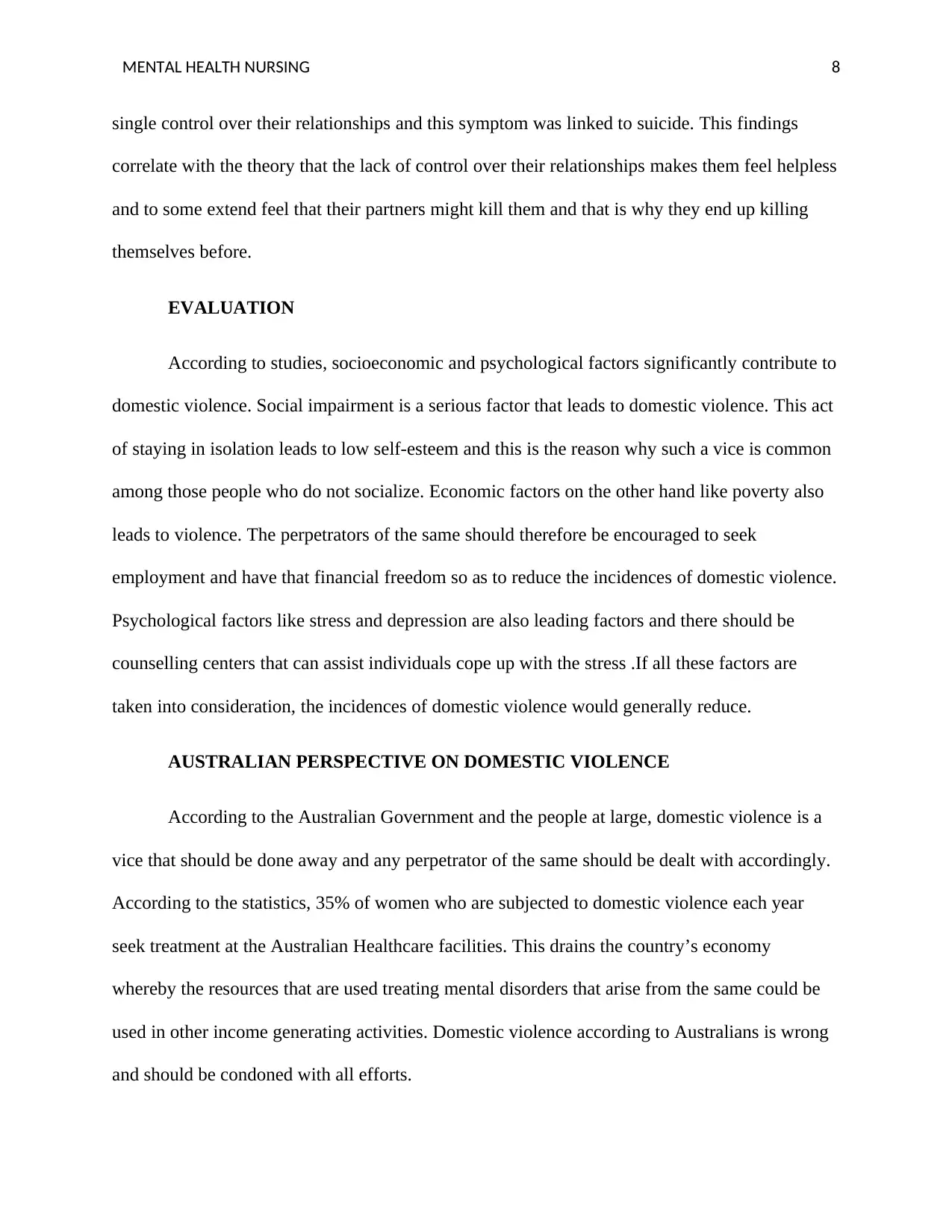
MENTAL HEALTH NURSING 8
single control over their relationships and this symptom was linked to suicide. This findings
correlate with the theory that the lack of control over their relationships makes them feel helpless
and to some extend feel that their partners might kill them and that is why they end up killing
themselves before.
EVALUATION
According to studies, socioeconomic and psychological factors significantly contribute to
domestic violence. Social impairment is a serious factor that leads to domestic violence. This act
of staying in isolation leads to low self-esteem and this is the reason why such a vice is common
among those people who do not socialize. Economic factors on the other hand like poverty also
leads to violence. The perpetrators of the same should therefore be encouraged to seek
employment and have that financial freedom so as to reduce the incidences of domestic violence.
Psychological factors like stress and depression are also leading factors and there should be
counselling centers that can assist individuals cope up with the stress .If all these factors are
taken into consideration, the incidences of domestic violence would generally reduce.
AUSTRALIAN PERSPECTIVE ON DOMESTIC VIOLENCE
According to the Australian Government and the people at large, domestic violence is a
vice that should be done away and any perpetrator of the same should be dealt with accordingly.
According to the statistics, 35% of women who are subjected to domestic violence each year
seek treatment at the Australian Healthcare facilities. This drains the country’s economy
whereby the resources that are used treating mental disorders that arise from the same could be
used in other income generating activities. Domestic violence according to Australians is wrong
and should be condoned with all efforts.
single control over their relationships and this symptom was linked to suicide. This findings
correlate with the theory that the lack of control over their relationships makes them feel helpless
and to some extend feel that their partners might kill them and that is why they end up killing
themselves before.
EVALUATION
According to studies, socioeconomic and psychological factors significantly contribute to
domestic violence. Social impairment is a serious factor that leads to domestic violence. This act
of staying in isolation leads to low self-esteem and this is the reason why such a vice is common
among those people who do not socialize. Economic factors on the other hand like poverty also
leads to violence. The perpetrators of the same should therefore be encouraged to seek
employment and have that financial freedom so as to reduce the incidences of domestic violence.
Psychological factors like stress and depression are also leading factors and there should be
counselling centers that can assist individuals cope up with the stress .If all these factors are
taken into consideration, the incidences of domestic violence would generally reduce.
AUSTRALIAN PERSPECTIVE ON DOMESTIC VIOLENCE
According to the Australian Government and the people at large, domestic violence is a
vice that should be done away and any perpetrator of the same should be dealt with accordingly.
According to the statistics, 35% of women who are subjected to domestic violence each year
seek treatment at the Australian Healthcare facilities. This drains the country’s economy
whereby the resources that are used treating mental disorders that arise from the same could be
used in other income generating activities. Domestic violence according to Australians is wrong
and should be condoned with all efforts.
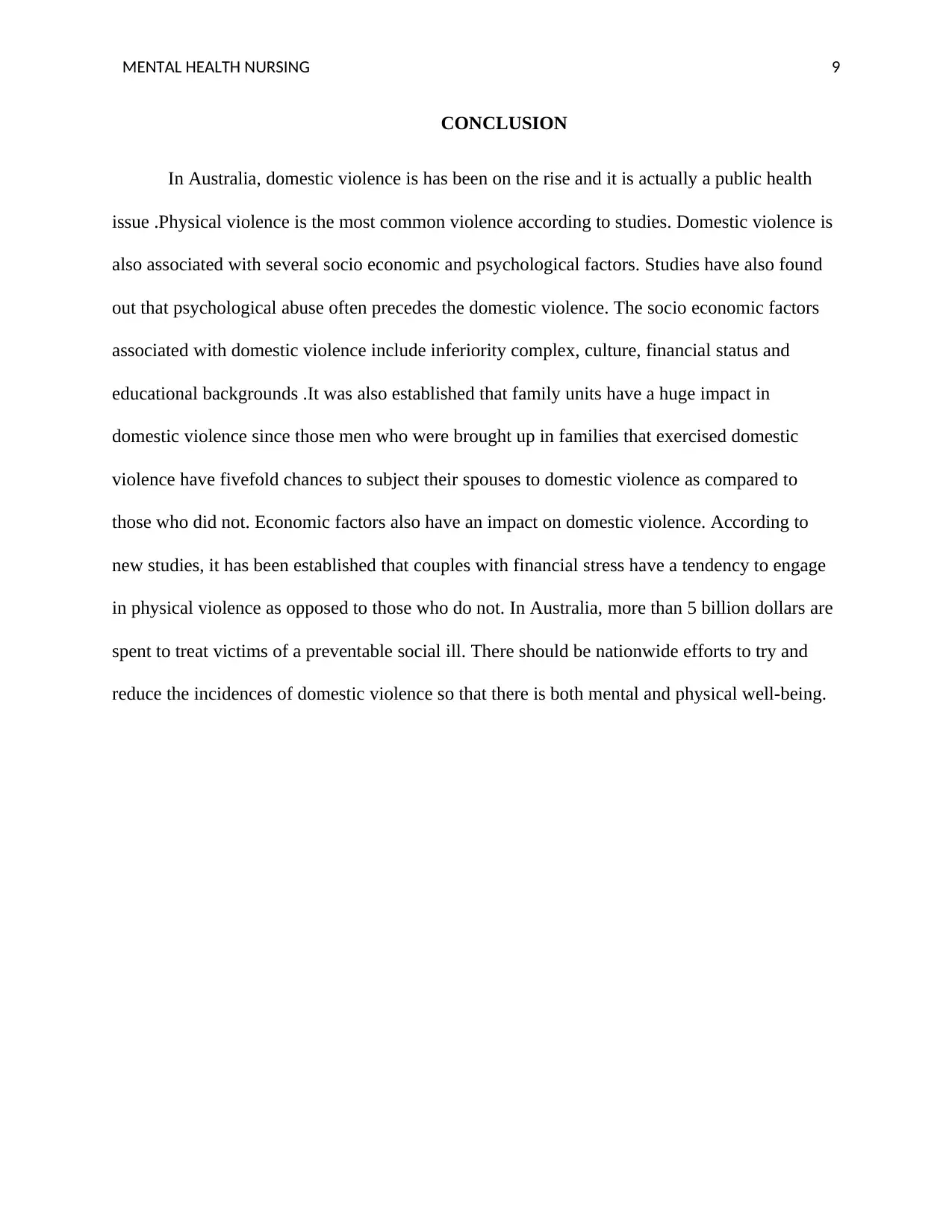
MENTAL HEALTH NURSING 9
CONCLUSION
In Australia, domestic violence is has been on the rise and it is actually a public health
issue .Physical violence is the most common violence according to studies. Domestic violence is
also associated with several socio economic and psychological factors. Studies have also found
out that psychological abuse often precedes the domestic violence. The socio economic factors
associated with domestic violence include inferiority complex, culture, financial status and
educational backgrounds .It was also established that family units have a huge impact in
domestic violence since those men who were brought up in families that exercised domestic
violence have fivefold chances to subject their spouses to domestic violence as compared to
those who did not. Economic factors also have an impact on domestic violence. According to
new studies, it has been established that couples with financial stress have a tendency to engage
in physical violence as opposed to those who do not. In Australia, more than 5 billion dollars are
spent to treat victims of a preventable social ill. There should be nationwide efforts to try and
reduce the incidences of domestic violence so that there is both mental and physical well-being.
CONCLUSION
In Australia, domestic violence is has been on the rise and it is actually a public health
issue .Physical violence is the most common violence according to studies. Domestic violence is
also associated with several socio economic and psychological factors. Studies have also found
out that psychological abuse often precedes the domestic violence. The socio economic factors
associated with domestic violence include inferiority complex, culture, financial status and
educational backgrounds .It was also established that family units have a huge impact in
domestic violence since those men who were brought up in families that exercised domestic
violence have fivefold chances to subject their spouses to domestic violence as compared to
those who did not. Economic factors also have an impact on domestic violence. According to
new studies, it has been established that couples with financial stress have a tendency to engage
in physical violence as opposed to those who do not. In Australia, more than 5 billion dollars are
spent to treat victims of a preventable social ill. There should be nationwide efforts to try and
reduce the incidences of domestic violence so that there is both mental and physical well-being.
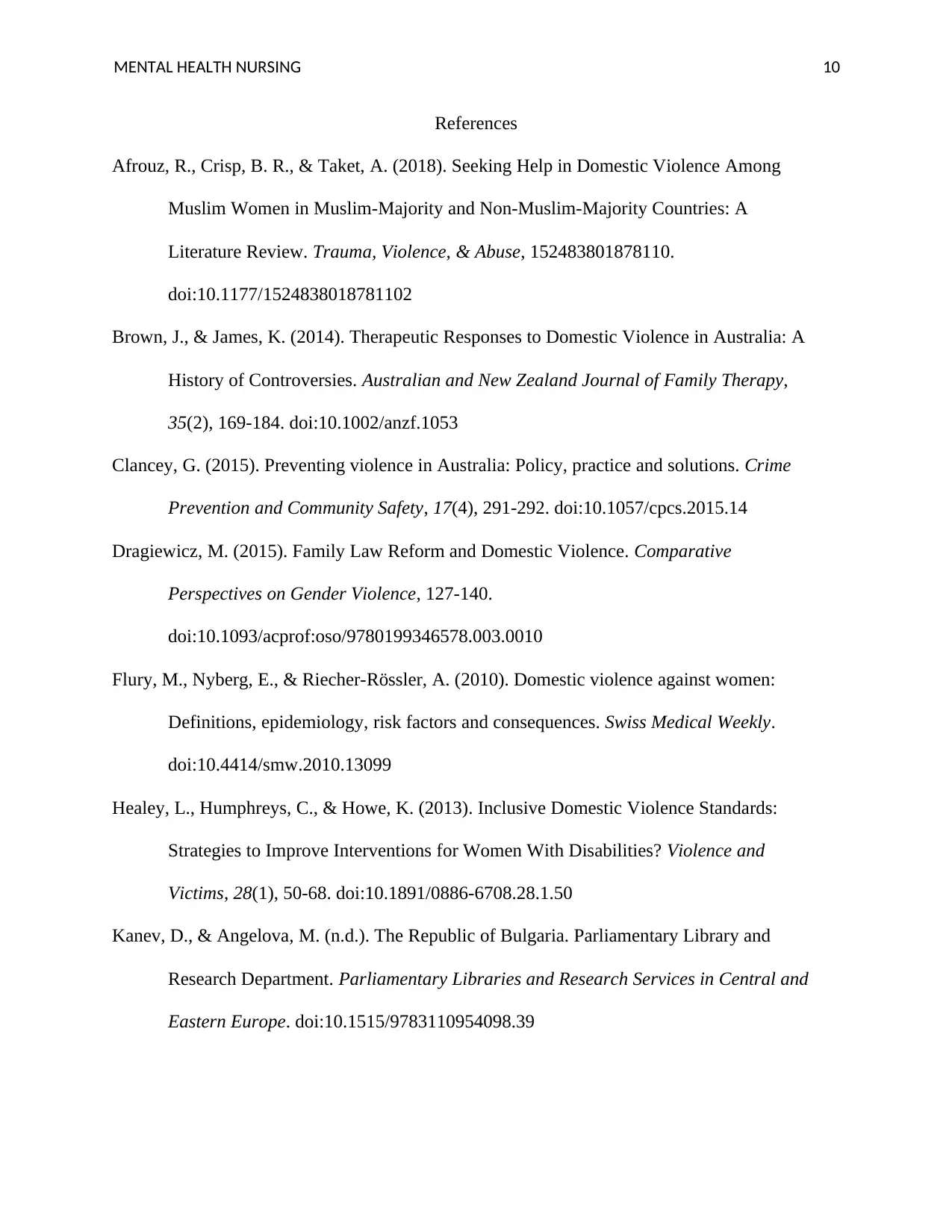
MENTAL HEALTH NURSING 10
References
Afrouz, R., Crisp, B. R., & Taket, A. (2018). Seeking Help in Domestic Violence Among
Muslim Women in Muslim-Majority and Non-Muslim-Majority Countries: A
Literature Review. Trauma, Violence, & Abuse, 152483801878110.
doi:10.1177/1524838018781102
Brown, J., & James, K. (2014). Therapeutic Responses to Domestic Violence in Australia: A
History of Controversies. Australian and New Zealand Journal of Family Therapy,
35(2), 169-184. doi:10.1002/anzf.1053
Clancey, G. (2015). Preventing violence in Australia: Policy, practice and solutions. Crime
Prevention and Community Safety, 17(4), 291-292. doi:10.1057/cpcs.2015.14
Dragiewicz, M. (2015). Family Law Reform and Domestic Violence. Comparative
Perspectives on Gender Violence, 127-140.
doi:10.1093/acprof:oso/9780199346578.003.0010
Flury, M., Nyberg, E., & Riecher-Rössler, A. (2010). Domestic violence against women:
Definitions, epidemiology, risk factors and consequences. Swiss Medical Weekly.
doi:10.4414/smw.2010.13099
Healey, L., Humphreys, C., & Howe, K. (2013). Inclusive Domestic Violence Standards:
Strategies to Improve Interventions for Women With Disabilities? Violence and
Victims, 28(1), 50-68. doi:10.1891/0886-6708.28.1.50
Kanev, D., & Angelova, M. (n.d.). The Republic of Bulgaria. Parliamentary Library and
Research Department. Parliamentary Libraries and Research Services in Central and
Eastern Europe. doi:10.1515/9783110954098.39
References
Afrouz, R., Crisp, B. R., & Taket, A. (2018). Seeking Help in Domestic Violence Among
Muslim Women in Muslim-Majority and Non-Muslim-Majority Countries: A
Literature Review. Trauma, Violence, & Abuse, 152483801878110.
doi:10.1177/1524838018781102
Brown, J., & James, K. (2014). Therapeutic Responses to Domestic Violence in Australia: A
History of Controversies. Australian and New Zealand Journal of Family Therapy,
35(2), 169-184. doi:10.1002/anzf.1053
Clancey, G. (2015). Preventing violence in Australia: Policy, practice and solutions. Crime
Prevention and Community Safety, 17(4), 291-292. doi:10.1057/cpcs.2015.14
Dragiewicz, M. (2015). Family Law Reform and Domestic Violence. Comparative
Perspectives on Gender Violence, 127-140.
doi:10.1093/acprof:oso/9780199346578.003.0010
Flury, M., Nyberg, E., & Riecher-Rössler, A. (2010). Domestic violence against women:
Definitions, epidemiology, risk factors and consequences. Swiss Medical Weekly.
doi:10.4414/smw.2010.13099
Healey, L., Humphreys, C., & Howe, K. (2013). Inclusive Domestic Violence Standards:
Strategies to Improve Interventions for Women With Disabilities? Violence and
Victims, 28(1), 50-68. doi:10.1891/0886-6708.28.1.50
Kanev, D., & Angelova, M. (n.d.). The Republic of Bulgaria. Parliamentary Library and
Research Department. Parliamentary Libraries and Research Services in Central and
Eastern Europe. doi:10.1515/9783110954098.39
Secure Best Marks with AI Grader
Need help grading? Try our AI Grader for instant feedback on your assignments.
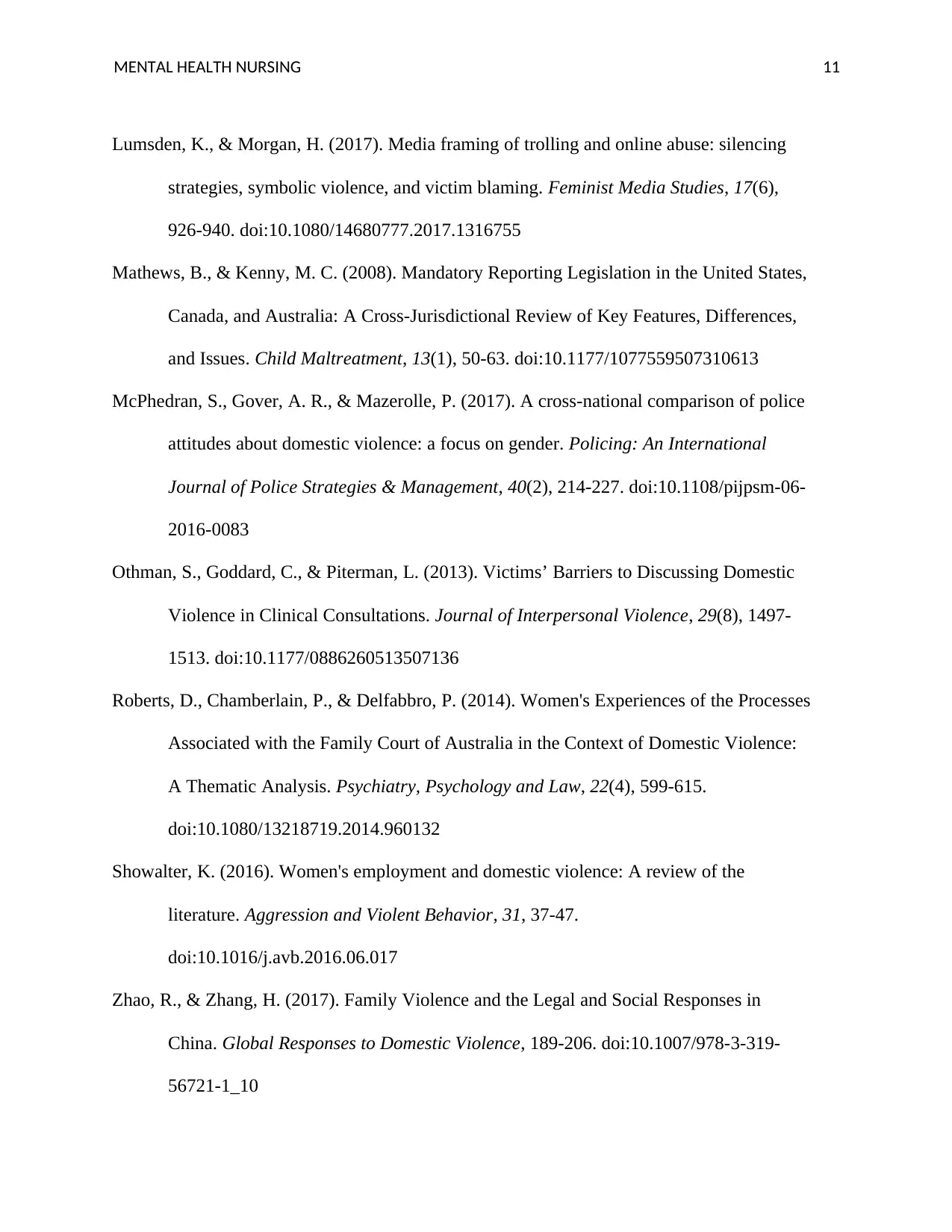
MENTAL HEALTH NURSING 11
Lumsden, K., & Morgan, H. (2017). Media framing of trolling and online abuse: silencing
strategies, symbolic violence, and victim blaming. Feminist Media Studies, 17(6),
926-940. doi:10.1080/14680777.2017.1316755
Mathews, B., & Kenny, M. C. (2008). Mandatory Reporting Legislation in the United States,
Canada, and Australia: A Cross-Jurisdictional Review of Key Features, Differences,
and Issues. Child Maltreatment, 13(1), 50-63. doi:10.1177/1077559507310613
McPhedran, S., Gover, A. R., & Mazerolle, P. (2017). A cross-national comparison of police
attitudes about domestic violence: a focus on gender. Policing: An International
Journal of Police Strategies & Management, 40(2), 214-227. doi:10.1108/pijpsm-06-
2016-0083
Othman, S., Goddard, C., & Piterman, L. (2013). Victims’ Barriers to Discussing Domestic
Violence in Clinical Consultations. Journal of Interpersonal Violence, 29(8), 1497-
1513. doi:10.1177/0886260513507136
Roberts, D., Chamberlain, P., & Delfabbro, P. (2014). Women's Experiences of the Processes
Associated with the Family Court of Australia in the Context of Domestic Violence:
A Thematic Analysis. Psychiatry, Psychology and Law, 22(4), 599-615.
doi:10.1080/13218719.2014.960132
Showalter, K. (2016). Women's employment and domestic violence: A review of the
literature. Aggression and Violent Behavior, 31, 37-47.
doi:10.1016/j.avb.2016.06.017
Zhao, R., & Zhang, H. (2017). Family Violence and the Legal and Social Responses in
China. Global Responses to Domestic Violence, 189-206. doi:10.1007/978-3-319-
56721-1_10
Lumsden, K., & Morgan, H. (2017). Media framing of trolling and online abuse: silencing
strategies, symbolic violence, and victim blaming. Feminist Media Studies, 17(6),
926-940. doi:10.1080/14680777.2017.1316755
Mathews, B., & Kenny, M. C. (2008). Mandatory Reporting Legislation in the United States,
Canada, and Australia: A Cross-Jurisdictional Review of Key Features, Differences,
and Issues. Child Maltreatment, 13(1), 50-63. doi:10.1177/1077559507310613
McPhedran, S., Gover, A. R., & Mazerolle, P. (2017). A cross-national comparison of police
attitudes about domestic violence: a focus on gender. Policing: An International
Journal of Police Strategies & Management, 40(2), 214-227. doi:10.1108/pijpsm-06-
2016-0083
Othman, S., Goddard, C., & Piterman, L. (2013). Victims’ Barriers to Discussing Domestic
Violence in Clinical Consultations. Journal of Interpersonal Violence, 29(8), 1497-
1513. doi:10.1177/0886260513507136
Roberts, D., Chamberlain, P., & Delfabbro, P. (2014). Women's Experiences of the Processes
Associated with the Family Court of Australia in the Context of Domestic Violence:
A Thematic Analysis. Psychiatry, Psychology and Law, 22(4), 599-615.
doi:10.1080/13218719.2014.960132
Showalter, K. (2016). Women's employment and domestic violence: A review of the
literature. Aggression and Violent Behavior, 31, 37-47.
doi:10.1016/j.avb.2016.06.017
Zhao, R., & Zhang, H. (2017). Family Violence and the Legal and Social Responses in
China. Global Responses to Domestic Violence, 189-206. doi:10.1007/978-3-319-
56721-1_10
1 out of 11
Related Documents
Your All-in-One AI-Powered Toolkit for Academic Success.
+13062052269
info@desklib.com
Available 24*7 on WhatsApp / Email
![[object Object]](/_next/static/media/star-bottom.7253800d.svg)
Unlock your academic potential
© 2024 | Zucol Services PVT LTD | All rights reserved.





